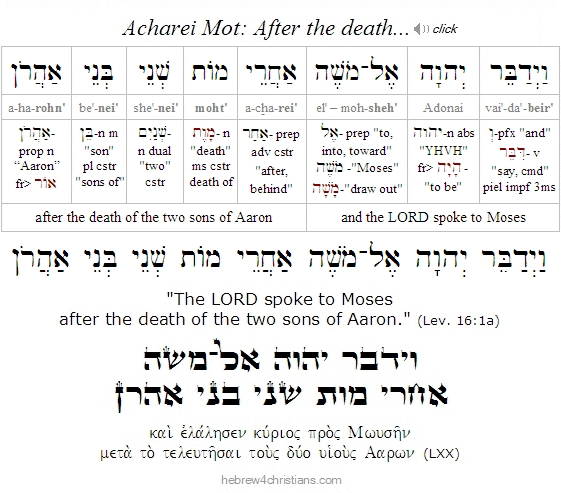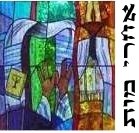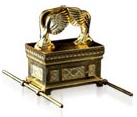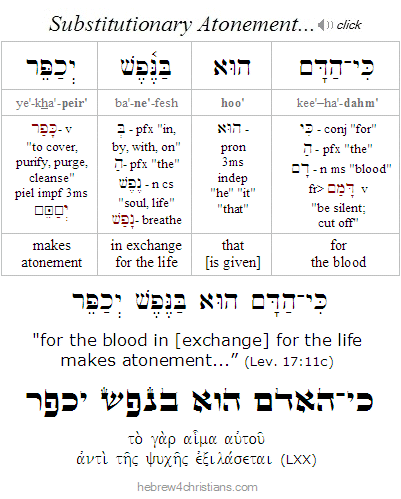|
|
 |
 |
 |
 |
|
Weekly Torah Reading
|
|
|
|
Parashat Acharei Mot ("after the death")
|
|
|
Click on the links to display the Scriptures:
|
|
|
|
 |
 |
 |
|
Torah Reading Overview
|
|
|
|
Acharei Mot (אַחֲרֵי מוֹת) transitions from the preceding instructions regarding ritual purity to recall the tragedy of Nadab and Abihu, two sons of Aaron that were killed when they offered esh zarah ("strange fire") upon the altar during the dedication of the Tabernacle. Because these priests approached the Holy Place in an incorrect manner and were killed, the LORD further instructed Moses to tell Aaron that he should enter the Holy of Holies only in a prescribed manner once a year, during the time of Yom Kippur.
|
|
|
 |
 |
|
The LORD spoke to Moses after the death of the two sons of Aaron,
when they drew near before the LORD and died." (Leviticus 16:1)
|
 |
 |
|
The Warning of Nadab and Abihu
|
|
|
 |
 |
|
The story of the death of Aaron's two oldest sons, Nadav (Nadab) and Avihu (Abihu), is given in parashat Shemini, where we learned that they decided to offer their own korban (sacrifice) in the Holy of Holies in the Mishkan (Lev. 10:1-11).
|
|
 |
 |
|
According to Jewish tradition, they reasoned that since ketoret (incense) was the holiest of offerings, and since the kodesh hakodashim (the Holy of Holies) was the holiest place, it would be best if they offered their gift to the LORD there.
Nadav and Avihu were essentially correct that giving an offering before the Shechinah in the Holy of Holies was the most sacred of korbanot, but they transgressed by presumptuously coming before the LORD without His consent -- and without the blood of sacrifice for their sins (perhaps they were intoxicated as well: Lev. 10:9-10). Their death was a means to sanctify the Name of the LORD, and to remind all Israel that it is indeed "a fearful thing to fall into the hands of the Living God" (Heb. 10:31). After all, if Queen Esther feared for her life by coming before King Ahasuerus unbidden, surely the kohanim (priests) should fear coming before the LORD God Almighty without His approval.
Therefore the LORD instructed Moses about how to come before His presence in the Holy of Holies and explained the special avodah (service) of Yom Kippur.
|
 |
 |
|
The Throne Room of God
|
 |
 |
|
The Holy of Holies is the antithesis of the profane -- the sacred place where God Himself would be manifest in the form of the Shechinah that dwelt (shachan) between the keruvim (Cherubim) over the kapporet (Seat of Atonement) of the Ark of Testimony. As such, it was utterly sacred and represented the throne room of God Himself in the midst of Israel.
|
 |
 |
|
No Jew could casually enter the Holy of Holies and expect to live, since God's absolute holiness and glory would consume him immediately. God's infinite perfection and irrepressible righteousness would demand that any transgressor be consumed by the very weight of His glory and power.
|
|
|
 |
 |
|
Access through blood atonement
|
 |
 |
|
But how, then, could Israel come before the King of Israel, the LORD of Glory? Only through an appointed representative who came bearing the blood of atonement on behalf of the sins of Israel, and only on an appointed day (Tishri 10), otherwise known as Yom Kippur ("Day of Atonement").
On this special day, considered the holiest day of the year, all of the korbanot (sacrifices) would be offered by the Kohen Gadol (High Priest) alone (i.e., not by any other priests) and only while he was divested of his "golden outward garments" and clothed exclusively in the white linen garments of humility.
Before performing the blood rituals, however, the High Priest first had to burn two handfuls of ketoret (incense) in the Holy of Holies. He would enter holding a spoon filled with ketoret in his left hand and a pan with burning coals in the other. He would carefully place the pan with the burning coals in front of the ark and then pour the ketoret from the spoon to his hands, which was then poured onto the glowing coals, filling the entire chamber with thick smoke. He would then walk slowly backwards, bowing before the Presence of the LORD.
Next the High Priest would perform the additional (musaf) sacrifices for the Yom Kippur service. These included animal sacrifices for all of Israel (a bull, a ram, seven sheep, and a goat), as well as the Kohen Gadol's personal korbanot (a bull for chatat offering and a ram for an olah). The High Priest would lay his hands upon the head of the bull and recite viduy (confession) three separate times - first for his own sins, then for the sins of the priesthood, and then for all of Israel. Then he would enter the Holy of Holies to sprinkle the blood of his chatat offering before the LORD. He would sprinkle the blood one time upward and then seven times down upon the kapporet ("Mercy Seat") of the ark. The flesh and the hide of the sin offerings were then taken "outside the camp" and burned.
(Note that it was only during the Yom Kippur avodah that the sacred Name of the LORD -- YHVH -- was spoken in full (at all other times the word Adonai was used in its place). In fact, the High Priest pronounced the sacred Name precisely 10 times on this occasion: three times during the viduy (confession) that itself was recited three times, and one more time when performing the chatat offering of the goat that was designated "for the LORD" (see below). When the people heard the High Priest recite the Name, they all fell on their faces and said, "Barukh shem kevod malkhuto l'olam va'ed" - Blessed be the Name (of the LORD) whose glorious kingdom endures forever." It later became halakhah (Jewish law) that whenever the Name of the LORD was pronounced, it had to be praised.)
|
 |
 |
|
The Two Goats
|
 |
 |
|
Two goats were selected earlier and were waiting in the courtyard of the mishkan. The High Priest would draw lots and select one of the two goats to be a chatat (sin) offering on behalf of the people (this goat was designated L'Adonai - "to the LORD"). He would then slaughter it and sprinkle its blood upon the kapporet as he did for his chatat offering earlier (this is the third time the High Priest entered the Holy of Holies on Yom Kippur).
|
 |
 |
|
After this, the High Priest would lay both hands upon the head of the second goat (designated "for Azazel," a name for Satan, the accusing angel) while confessing all of the transgressions of the people. This goat, which symbolically represented the sins of the people, was then taken into the wilderness by a messenger and pushed off a cliff, causing the goat to be smashed to pieces.
|
|
|
 |
 |
|
(A midrash relates that the people were so eager to get the Azazel goat thrust over the cliff that they sometimes ran alongside the messenger and pushed him along the way.)
The fourth and final entrance into the Holy of Holies was when the High Priest returned to retrieve the spoon and the pan that had been used for burning the ketoret. While the High Priest did this, the people would be fasting and praying in eager anticipation of the outcome of the rituals. After completing his tasks, the people cheered the High Priest and waited to kiss his hand at the entrance of the mishkan.
The section on Yom Kippur avodah ends as follows:
And it shall be a statute (chok) to you forever (olam) that in the seventh month, on the tenth day of the month (i.e., Tishri 10), you shall afflict yourselves and shall do no work (melakhah)... For on this day shall atonement (kaphar) be made for you to cleanse you. You shall be clean (tahor) before the LORD from all your sins. It is a Sabbath of solemn rest to you (shabbat shabbaton), and you shall afflict yourselves; it is a statute forever (chukkat olam).... And the priest who is anointed and consecrated as priest in his father's place shall make atonement, wearing the holy linen garments (bigdei hakodesh). He shall make atonement for the holy sanctuary (mikdash hakodesh), and he shall make atonement for the tent of meeting (ohel mo'ed) and for the altar (mizbe'ach), and he shall make atonement for the priests and for all the people of the assembly (am hakahal). And this shall be a statute forever (chukkat olam) for you, that atonement (kaphar) may be made for the people of Israel once in the year because of all their sins." And Moses did as the LORD commanded him (Lev. 16:29-34).
|
 |
 |
 |
 |
|
The Place of Sacrifice
|
|
|
|
After the laws for Yom Kippur were given, the parashah continues with the commandment that the Jews were only to offer their korbanot at the mishkan and not in the open fields where pagan sacrifices were offered. Those who violated this commandment were subject to  (kareit), a "cutting short" of one's life. (kareit), a "cutting short" of one's life.
|
|
|
|
Laws against eating Blood
|
|
|
|
Moreover the eating of blood is strictly forbidden and likewise subject to being kareit, having their lives "cut short":
"For the life of the flesh is in the blood, and I have given it for you on the altar to make atonement for your souls, for it is the blood that makes atonement by the life." (Lev. 17:11)
The parashah concludes with commandments about deviant sexual relations, including incest, homosexuality, and bestiality. On account of these practices the other nations were judged by the LORD and driven out of the land.
|
|
|
Yom Kippur after the Crucifixion of Yeshua
|
|
 |
 |
|
The Talmud relates fascinating information about various miracles that began occurring some 40 years before the destruction of the Temple (i.e., 30 AD). These miracles are ascribed to the zechut (merit) of a certain Shimon HaTzaddik, who was a highly respected High Priest of Israel. However, since these signs began just after the time of Yeshua's crucifixion, they further indicate that the parochet of the Holy of Holies has been rent asunder, and now, by means of His avodah and zechut for those who trust in Him, the way to the throne of grace has been made accessible to all. Here's the quote from the Talmud:
Our rabbis taught: During the last forty years before the destruction of the Temple the lot ['For the Lord'] did not come up in the right hand; nor did the crimson-colored strap become white; nor did the western most light shine; and the doors of the Hekel [Temple] would open by themselves" (Soncino version, Yoma 39b).
According to this passage, the lot for Azazel, contrary to all the laws of probability, came up 40 times in a row in the left hand.... This was considered a dire event and signified something had fundamentally changed in the Yom Kippur avodah.
The second miracle concerns a crimson strap that was tied to the Azazel goat. The custom was to cut a portion of this strap and tie it to the Temple door. After the Azazel goat was killed, the strap on the Temple door turned white to signify the successful atonement of Israel. However, beginning around 30 AD, the strap remained crimson each year to the time of the Temple's destruction.
The third miracle was that the ner ma'aravi, the westernmost ight of the menorah in the Holy Place, was found extinguished before the next morning. This was highly unusual because before this time the ma'aravi remained lit throughout the night and was normally used by the priests to rekindle the other branches of the menorah. After 30 AD, however, this light -- the shamash -- was no longer found burning, even despite various attempts to ensure that it remained lit through the night.
The fourth miracle was that beginning around 30 AD the Temple doors swung open every night of their own accord. Yochanan ben Zakkai declared that this was a sign of impending doom (Sotah 6:3) that foreshadowed that the Temple itself would be destroyed.
|
 |
 |
 |
 |
 |
 |
 |
|
 |
|
|
|
Haftarah Reading Overview
|
|
|
|
The Haftarah reading from Ezekiel 22 indicts Israel for failing to obey the Torah of Moses and consequently invokes the judgment of the LORD, which includes the Diaspora of the Jewish people:
"I will scatter you among the nations and disperse you through the countries, and I will consume your uncleanness out of you. And you shall be profaned by your own doing in the sight of the nations, and you shall know that I am the LORD."
Notice, however, that the purpose of the Diaspora is to "consume the uncleanness" out of the Jewish people, and therefore is ultimately restorative.
|
|
|
 |
|
|
|
Brit Chadashah Overview
|
|
|
|
The Brit Chadashah reading tells us that the Mashiach Yeshua appeared as the High Priest (Kohen Gadol) of the true tabernacle (of which the earthly tabernacle was merely a shadow) and there offered His own blood to secure eternal redemption for those who are trusting in Him. Yeshua did this by dying on the cross and shedding His blood as the perfect sacrificial victim for the penalty of sins committed under the Torah of Moses.
In the first covenant (i.e., the Torah of Moses), innocent sacrificial victims had to be killed in order to benefit from their death. This is most evident in the Yom Kippur ceremony where the sins of the nation were covered by the "blood of bulls and goats" for the previous year's sins. But this ritual, like the others instituted in the earthly tabernacle, foreshadowed the coming Substance that was prophesied (Hebrews 8:5).
A testament is not of force until the testator is dead. That is, a "will" comes into effect only after someone dies. The New Covenant of Almighty God was put into effect when Yeshua the Mashiach was sacrificed and died, and the heirs to this "will" receive eternal forgiveness for their sins - unlike the contingent forgiveness obtained by the rituals offered in the earthly pattern of the true Holy Place.
Trying to live under two covenants at the same time is similar to being married to two women at once - which is a form of spiritual adultery. Those who are joined ["married" KJV] to Mashiach are dead to (i.e., separated from) the Torah of Moses (Rom. 7:2-4).

You also have died to the Torah through the body of Christ
Praise the God of Israel for our High Priest Jesus, the Mediator of the New Covenant through His sacrifice for us!
One of the roles of our beloved Mashiach Yeshua (Jesus Christ) is that of Kohen HaGadol (High Priest) who offered true kapparah [atonement] for our sins by offering His own blood in the Holy of Holies made without hands. As it is written in the letter of Hebrews:
Therefore, holy brothers, you who share in a heavenly calling, consider Jesus, the apostle and high priest of our confession, who was faithful to him who appointed him, just as Moses also was faithful in all God's house. (Hebrews 3:1-2)
|
|
|
|
The Importance of a Blood Sacrifice
|
|
 |
 |
|
In Leviticus 17:11 it is written:
"For the life of the flesh is in the blood, and I have given it for you on the altar to atone (l'kapeir) for your souls, for it is the blood that makes atonement (y'khapheir) by the life."

A blood sacrifice is required by the LORD for the issue of sin. Leviticus 17:11 agrees with Hebrews 9:22: "Without the shedding of blood there is no remission." In Yoma 5a it is likewise written, "There is no atonement without blood." The substitutionary shedding of blood, the "life-for-life" principle, is essential to the true "at-one-ment" with the LORD God.
Yeshua offered His own body up to be the perfect Sacrifice for sins. By His shed blood we are given complete atonement before Adonai. The Levitical system of animal sacrifices, including the elaborate Yom Kippur ritual, was meant to foreshadow the true and abiding Sacrifice of Yeshua as the means of our reconciliation with God. The B'rit Yeshanah (Older Covenant) provides a shadow of the substance revealed in the B'rit Chadashah (New Covenant). If the older covenant had been sufficient to provide a permanent solution to the problem of our sin, there never would have been need for a new covenant to supersede it (Hebrews 8:7).
Under the former or older covenant, sacrifices merely "covered" sins, but under the new covenant, these sins are taken entirely away (Hebrews 7:27, 9:12, 9:25-28). There is no more need for continual sacrifices, since Yeshua provided the once-and-for-all sacrifice for all of our sins (Hebrews 9:11-14; 9:24-28; 10:11-20).
Indeed, Yeshua is the "propitiation" or "expiation" for our sins. The Greek word used in Romans 3:25, 1 John 2:2, and 1 John 4:10 ("hilasterion") is the same word used in the LXX for the kapporet [seat of atonement on the ark of the covenant] in the Holy of Holies which was sprinkled with the blood of the sacrifice on Yom Kippur.
For Messiah has entered, not into holy places made with hands, which are copies of the true things, but into heaven itself, now to appear in the presence of God on our behalf. Nor was it to offer himself repeatedly, as the high priest enters the holy places every year with blood not his own, for then he would have had to suffer repeatedly since the foundation of the world. But as it is, he has appeared once for all at the end of the ages to put away sin by the sacrifice of himself... So Messiah, having been offered once to bear the sins of many, will appear a second time, not to deal with sin but to save those who are eagerly waiting for him. (Hebrews 9:24-ff)
For by one offering he hath perfected for ever them that are sanctified.
(Hebrews 10:14)
Blessing:
|
 |
|
|
 |
|
|
 |
 |
|
Hebrew Audio Files:
|
|
 |
 |
|
Click the following links to hear the desired chapters read from this week's Torah:
|
|









